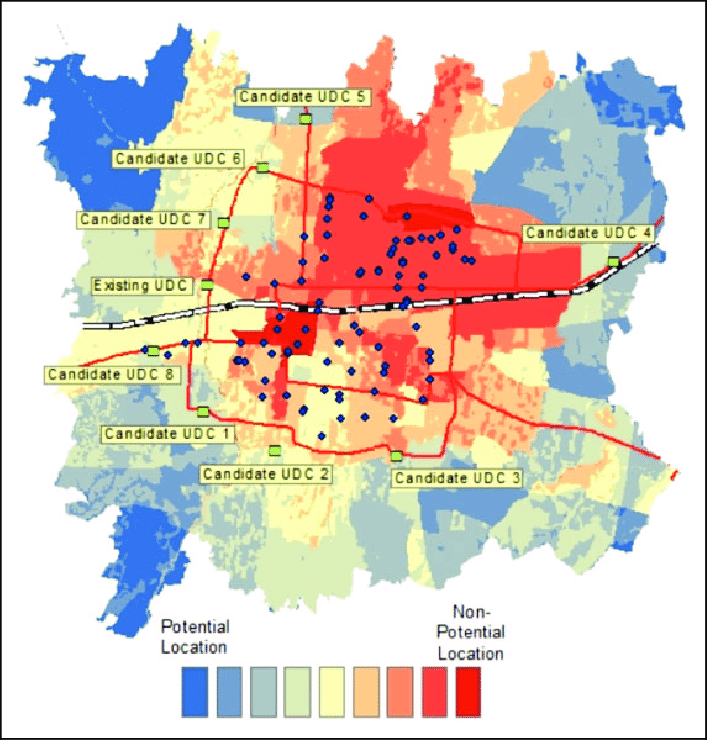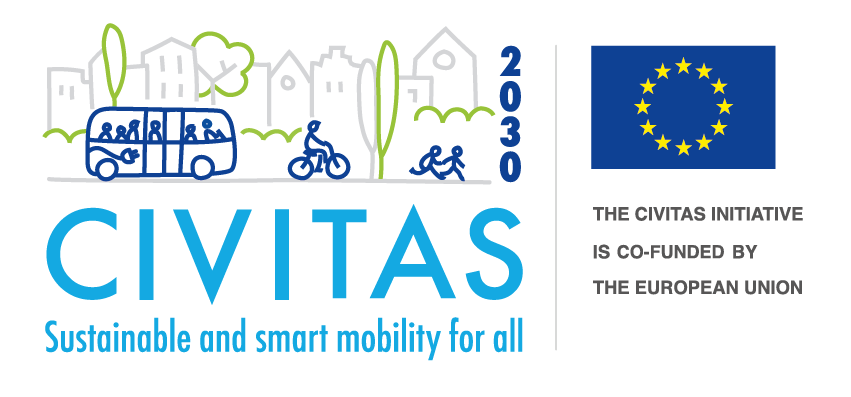Data-driven decision support tools for Urban Freight Transport (UFT) planning
Data-driven decision support tools for Urban Freight Transport (UFT) planning
By Philipp Müller, Daniela Kirsch, & Sandra Jankowski (Fraunhofer IML), and Nacho Sarrió & Lorena Axinte (Bax & Company).
Urban areas are melting pots of a multitude of interests. If we look at Urban Freight Transport (UFT), it’s clear that many different stakeholder demands need to be fulfilled. Logistics service providers want to operate smoothly and efficiently without external restrictions, local companies require on-time deliveries to ensure complete assortment or functioning production processes, citizens expect to benefit from on-demand goods access while not being disturbed by UFT processes, and local authorities have to harmonise these requirements while handling negative externalities like congestion, air and noise pollution, or even safety. The key problem here is the limited space and time to satisfy the different needs of these stakeholders. However, there is a way we can better understand, optimise and plan Urban Freight Transport processes, by using one of the key resources of our time: data.

How to better fulfil the 7 Rights of logistics with data
UFT is fundamental for a functioning city and its importance continues to grow as cities across the EU attract more and more people from rural areas. European countries are already highly urbanized (2020: 74.9%) compared to the rest of the world, and the United Nations expect that 83.7% of the European population will live in cities in 2050 (United Nations 2018).
Logistics has always been about fulfilling its 7 Rights “(…) to deliver the right product, in the right quantity and the right condition, to the right place at the right time for the right customer at the right price” (Swamidass (Ed.) 2000). These pillars may still be the foundation of logistics but, especially in urban areas, the circumstances have become increasingly more complex: entry restrictions like time windows for deliveries or low/zero-emissions zones are two examples that affect the business of companies dependent on logistics services. On top of regulating UFT, city authorities must also take close care to ensure the supply of goods into, within, and out of the city while also harmonising the coexistence between all (non-)road users.
“A wide range of static and real-time data sources exist nowadays. These can be used to quantify UFT more precisely than ever before to best understand reality, including the flow of goods and all possible interactions.“
Data-driven decision making can be a key pillar to optimise UFT and its planning regarding societal, environmental and/or economic aspects. Furthermore, this can be done from the point of view of different stakeholders, which is also useful in enabling a more flexible and accurate analysis that considers all possible players. Over the past decades, especially with the rise of the public internet in the early 1990s, technologies – besides traditional methods like surveys – have gradually emerged (and have become more affordable) which fosters the collection of (real-time) data like:
- GPS
- Sensors (for emissions, weight, acceleration, speed etc.)
- Smart devices (like handhelds, tablets, smartphones etc.)
- Image processing devices
Additionally, a wide range of static and real-time data sources exist nowadays. These can be used to quantify UFT more precisely than ever before to best understand reality, including the flow of goods and all possible interactions. But as the involved stakeholders differ, so do the intentions in making data-driven decisions. This leads to different purposes for analysing data such as:
- Tracking and tracing
- Understanding traffic impacts (like emissions, noise etc.)
- Optimising traffic flow and routing in advance or on the fly
- Increasing freight utilisation
- and more
Different kinds of data sources, may they be static or real-time data, can be valuable for these undertakings as they lead to a better understanding of the triggers and impacts of UFT. Depending on the level of data detail, these aspects can be broken down from a city-wide perspective to as focused as single streets. Besides the presented purposes, one can apply additional advanced data analytics techniques to incorporate predictions. Examinations can be enriched for example with other data sources like weather forecasts, time, or weekday related factors (e. g. traffic density, school opening and closing times) to better estimate future scenarios and shape UFT decisions more accurately, e. g. avoiding traffic peaks by postponing or re-routing transport flows.
“To diminish reservations against privacy concerns, data processors should respect the sovereignty of data owners and ensure that they follow the EU’s General Data Protection Regulation.“
Data, may it be public or private, often possesses fundamental importance and value for its owner. Therefore, it seems clear that different challenges can occur, and certain boundaries must be kept in mind when gathering data. On the same line, sharing data is widely regarded as a sensitive topic and often connected with privacy concerns for most private companies and even public entities. Many fear weakening their market position by exposing too many insights into their own processes. That’s why some technologies enabling these collections are forbidden in certain European countries or can only be used by following strict restrictions. Therefore, to diminish reservations against privacy concerns, data processors should respect the sovereignty of data owners and ensure that they follow the EU’s General Data Protection Regulation.
However, to create meaningful results, a certain degree of transparency and expression of data is necessary. This implies that data reported from third parties to others, like local authorities, should be accurate and it must be clear which application created them. Furthermore, expertise in data requirements and processing is necessary to evaluate what kind of data is needed for a specific purpose. Lastly, it should be clear in which format, where, and to what kind of degree data should be made accessible to which interested groups.
This data and derived insights foster knowledge of UFT and change in serving sustainability objectives set by a city. The process model of Sustainable Urban Logistics Planning (SULP) provides target-oriented guidance for local authorities in reaching these objectives. In this respect, performance indicators and parameters support the analysis of the current UFT situation and its impacts on the city, especially against the background of the increasing importance of UFT through e-commerce. In the SULP process “(…) key components [are] a thorough assessment of the current situation and future trends, a widely supported common vision with strategic objectives [and an] implementation [of measurements which] should be accompanied by reliable monitoring and evaluation.” (Aifandopoulou & Xenou, 2019) For local authorities, ex-ante and ex-post assessments of the UFT measurements are crucial in understanding whether the desired outcome is achieved.
Data collection, processing and updating can be a time and cost-consuming undertaking for cities and other interested parties. To understand the value and expression of data, one must always keep in mind that data analysis should be seen as a multi-stakeholder approach; one’s advantage might be the other’s disadvantage. Nevertheless, even though many aspects can be quantified by using data, soft factors (like the acceptance of certain technologies or concepts) remain fundamentally important for the understanding of UFT.
In conclusion, it is important to stress that closer cooperation between private and public stakeholders can lead to benefits for them all. In the case of traffic flow management, it can reduce congestion and emissions while private companies can increase their process efficiency. Finding commonly supported solutions based on data is widely viewed as both likely and preferable.
How data will change the logistics market
“Data-driven decision support tools can be, on the one hand, advantageous for private actors, and on the other, a pillar for local authorities in becoming a smarter and more sustainable city regarding UFT and SULPs.“
The importance of data-driven UFT planning will continue to grow as technological possibilities do. Data is widely regarded as “the new oil” of this century (Szczepański 2020). This leads, in a way, to the entrance of new players into the UFT market. Accordingly, it is expected that large tech companies and innovative start-ups will continue to establish themselves in the upcoming years and offer further diversified services tackling aspects of this market. This trend shows that knowledge gained by companies already owning a lot of (customer) data can help them lower the entry barriers to the urban logistics sector and collect even more data whilst taking care of the supply chain.
Most technologies will continue to evolve further and become more affordable too. This fact will foster the collection of data from many sources, plus emphasises the inclusion of processing and analysing processes to implement new or optimise existing UFT business models in economic, societal and environmental terms.
It can be concluded that using data-driven decision support tools can be, on the one hand, advantageous for private actors, and on the other, a pillar for local authorities in becoming a smarter and more sustainable city regarding UFT and SULPs.
The ULaaDS connection
The ULaaDS project is an example of collaboration between public and private actors and how data can be used in understanding and shaping UFT. One of the project goals is to develop concepts and test solutions for future-oriented, on-demand, urban logistics in different cities across Europe. Such research trials cover the use of cargo bikes, containerised micro-depots, as well as consolidation centres, among others. Throughout the project, urban planners, city leaders, logistics operators and researchers come together to share insights and exchange data regarding these ULaaDS concepts with the intention to better understand existing and new solutions.
One pillar represents increasing the data-based understanding and decision making of these concepts to enable the best deployment and development of such models. To compare the different research trials, an impact assessment framework is built on existing knowledge in the field of UFT obtained through literature review, studying documentation from other EU projects, and leveraging the ULaaDS partners’ expertise. The areas of impact that will be covered by gathering data are environmental and economic impacts as well as land use, traffic conditions and logistics impacts, among others. Furthermore, soft factors like user experience, acceptance and awareness will round off the picture.




